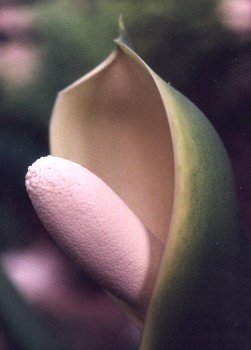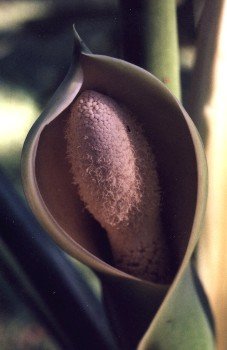Philodendron
by Valerie (August 5, 2001)

One of the few plants we keep in a pot is a huge split-leaf philodendron (Philodendron selloum). It started out as a cute little plant for a bathroom, but quickly outgrew pot after pot, as well as the house. We leave it in a shady location during the summer and used to bring it into the house, then the garage for the winter. Now it is so large that we just cover it with a king-sized sheet when we have a freeze and it has suffered no damage so far. The glossy leaves are about 2 feet long, and the trunk, at least 12 years old, is almost that tall. It produces aerial roots at almost every leaf junction along its trunk and so looks like it's covered with thin snakes or thick worms. For many years the plant just kept growing new leaves, getting taller, and requiring larger pots. Just recently, however, it bloomed. While the blossom was not showy or colorful, it was definitely interesting. This type of flower doesn't have the usual obvious petals and center. The first thing to appear is called a spathe, which is an outer sheath, or bract. This opened one morning and revealed a large, white spadix, a spike covered with the tiny flowers. They looked like white sand grains pressed flat around a rather suggestive shape. That evening, the spathe closed up again. The following day it opened and the spadix then looked all hairy as its covering of tiny flowers must have been open, revealing stamens and pistils. The only insects that I saw attracted to the blossoms were little black ants. That evening the bract closed again and stayed tightly shut. After a week or so, the whole structure rotted and fell off.
 
|